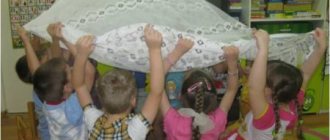Communication game “Friendship” (middle group)
Construct
organizing joint educational activities
according to PM.02 Organization of various types of activities and communication of children Ponomareva Tatyana
33 b groups
DOO:
Age group:
middle group (4 - 5 years)
Head of practice:
Temereva Lyudmila Petrovna
Methodist:
Ibragimova Daria Andreevna
Integration of educational areas:
Social and communicative development, speech development.
Kind of activity
: communication game
Subject:
"Friendship"
Form of organization:
group
Planned result:
Children show polite behavior towards their peers.
Children are able to regulate their actions in accordance with the rules of the game and form ideas about the rules of friendship.
Children have an idea of the concept of “friendship”.
Children have ideas about what qualities a friend should have
Children are able to analyze their feelings and the results of joint activities.
Children take part in group games.
Target:
nurturing a valued attitude towards friendship, friends, polite attitude towards peers, developing experience in participating in group games.
| Tasks | Tasks taking into account the age characteristics of children |
| Educational: cultivate a polite attitude towards peers, a value-based attitude towards friendship. Developmental: develop the ability to regulate your actions in accordance with the rules of the game, formulate the rules of friendship. develop the ability to analyze your thoughts and feelings, Educational: to form ideas about the concept of “friendship”, to develop the experience of participating in a collective game | Christina – develop perseverance |
Principles of education:
creating a positive emotional uplift, education through interaction, education through creativity.
Principles of training:
the principle of psychological comfort, the principle of activity.
Education methods:
methods of forming social experience (game); a method for children to comprehend their social experience (conversation); stimulation methods (creating a situation of success).
Teaching methods:
methods for developing cognitive interest (building a game plot, stimulating with entertaining content), methods for developing mental functions (creative task “building a ship”, creating a creative field).
List of sources used:
Federal state educational standard for preschool education. / Ministry of Education and Science of the Russian Federation, order dated October 17, 2013 N 1155.
Program "From birth to school". Basic general education program of preschool education / ed. N.E. Veraksy, T.S. Komarova, M. A. Vasilyeva. – M: Mosaic – synthesis, 2014; Federal State Educational Standard.
Progress of joint activities
| Stages of activity | Methods | Activities of a teacher | Children's activities | Planned result |
| 1. Organizational moment Task: attract children's attention. Motivate children for upcoming activities. | Emotional stimulation, demonstration. Conversation | The teacher motivates children to work together. - Guys, look, the postman brought an envelope, let's open it. Guys, this is a flash drive, do you want to know what's on it? The teacher takes out a flash drive from the envelope. Inserts it into the laptop and listens to the song “True Friend” (words by M. Plyatskovsky, music by B. Savelyev). — Guys, did you like the song? What is it about? That's right, about friendship. What is friendship? What are friends for? Who can you call a friend? Can an adult be your friend? (grandmother, father, mother, grandfather). Yes, because they love us, take care of us, read books to us. They teach us, buy us toys, candy... How do you think. Can a dog be your friend? Yes maybe. She protects us from evil people, plays with us. A friend can be any pet that lives in the house. - Guys, look who came to visit us today. Hello, monkey. What happened to you, why are you crying? Monkey: “What is it? Why am I always alone and alone? No one plays with me, no one says a kind word? I don’t know what friendship is and who friends are?” (crying) - Don't cry, monkey. Stay with us. The guys and I will teach you how to be friends and you will have many friends. Really, guys? — Guys, where does friendship begin? (With a smile) That's right, let's smile at each other. Guys, do you think that in order to meet people and make new friends, you need to know polite words? Do you know polite words? | They participate in dialogue, respond emotionally to the game situation, and make decisions. | |
| Children's attention is concentrated, children are motivated for the upcoming activity. | ||||
| 2. Main stage 2.1. Exercise “ Say the Word ” cultivate a polite attitude towards peers, a valued attitude towards friendship | Building a game plot, conversation, creating a situation of success, stimulation with entertaining content, game | - Guys, let's play a game, it's called “Say the Word.” Do you want to play? I will not read you a short poem to the end, but you will have to finish it. Do you agree? Then let's begin! 1. If you meet an acquaintance, either on the street or at home, Don’t be shy, don’t be disingenuous, but say louder... (hello) 2. If you ask for something, then first don’t forget to Open your lips and say... (please) 3. If You don’t want to be considered ignorant, I beg you, be wise, Begin your request with a polite word: Be kind and be….(kind) 4. If you meet a company, not hastily, not in advance, Then at the moment of parting, tell everyone….. (goodbye ) 5. If someone helped you in word or deed, Do not hesitate to speak loudly and boldly... (thank you) - Well done. So the first rule of friendship is: be polite and always smile. Our guys, the monkey, are very friendly, they try not to quarrel. | Take part in the game, show interest in peers, interact with each other | Children treat their peers politely. |
| 2.2. Game "Yes-yes-yes, no-no-no" develop the ability to regulate your actions in accordance with the rules of the game; formulate the rules of friendship; form ideas about the concept of “friendship” | Creating a situation of success, conversation, game, stimulation with entertaining content, game | - Well, to teach the monkey what real friends should be, let's play an interesting game. I will ask questions, and you will answer “yes, yes, yes” or “no, no, no.” Will we be strong friends? (yes-yes-yes) Treasure our friendship? (yes-yes-yes) Will we learn to play? (yes-yes-yes) Shall we help a friend? (yes-yes-yes) Do you need to piss off your friend? (no-no-no) And give a smile? (yes-yes-yes) Is it worth offending a friend? (no, no, no) Shall we drink tea with friends? (yes-yes-yes) Will we be strong friends? (Yes Yes Yes) Well done! We completed the task. Now the monkey knows what real friends should be like. | Listen to the rules of the game, actively participate in a group game, analyze the results of joint gaming activities, interact with each other | Children know how to regulate their actions in accordance with the rules of the game. Children know about the rules of friendship. Children have an idea of the concept of “friendship”. |
| 2.3. Game "Compliments" Task: to develop the experience of participating in a collective game | conversation, play, stimulation with entertaining content. | The teacher organizes the interaction of children, stimulates the activity of children, encourages them to participate in joint group games - Guys, do you know what compliments are? That's right, compliments are good and kind words. Monkey, do you know any compliments? Monkey: No, guys, I don’t know. Then let's teach the monkey to give compliments. Let's stand in a circle. You will take turns turning to your neighbor on the right, shaking your palms and saying, “Sasha, you are kind.” And so on. Example words: cheerful, beautiful, fast, bold, courageous, caring, polite, cultured, hardworking, friendly. A person's mood lifts from good words. -Guys, you know so many compliments. I'm very happy! Now the monkey knows what compliments are and how to use them. | Show active participation in the game, analyze the results of the collective game, interact with each other | Children take part in group games. |
| 3. Reflection Task: develop the ability to analyze your feelings, analyze the results of joint activities. | Conversation, stimulation with entertaining content. | The teacher stimulates reflection on the emotional states of children -Guys, we have completed all the tasks with you. Why do you think we were able to fulfill them? (because we were friendly) That's right, we were friendly. Monkey, did we help you? Monkey: Yes, now I know what true friendship is, thanks guys. Now you are my friends, will you take me to live with you in your kindergarten? | Analyze the results of activities, sum up the results of joint activities. | Children are able to analyze their feelings and the results of joint activities. |
| 4. Openness Task: Encourage children to engage in independent activities. | Emotional stimulation | - And now, after a lot of work done, I suggest you relax a little and go for a walk, walk with the monkey. | Express their thoughts and feelings | Children are focused on independent activity. |




